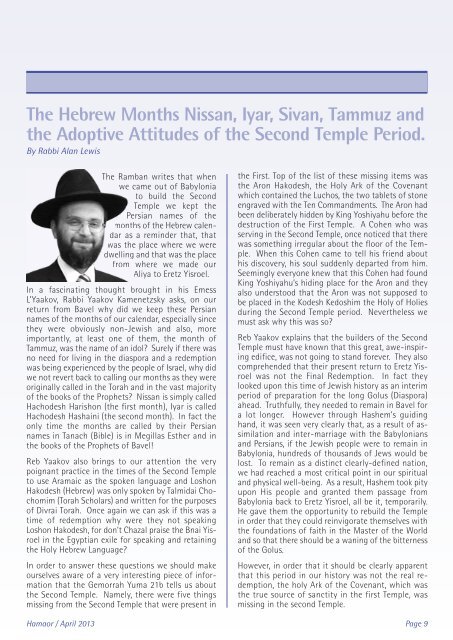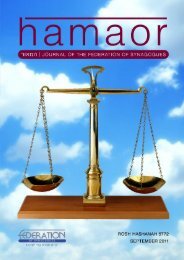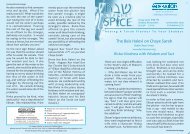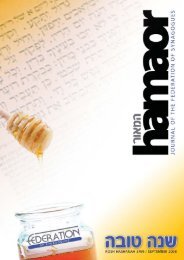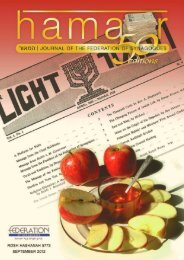Pesach 5773 - 18/03/2013 - Federation Of Synagogues
Pesach 5773 - 18/03/2013 - Federation Of Synagogues
Pesach 5773 - 18/03/2013 - Federation Of Synagogues
Create successful ePaper yourself
Turn your PDF publications into a flip-book with our unique Google optimized e-Paper software.
The Hebrew Months Nissan, Iyar, Sivan, Tammuz and<br />
the Adoptive Attitudes of the Second Temple Period.<br />
By Rabbi Alan Lewis<br />
The Ramban writes that when<br />
we came out of Babylonia<br />
to build the Second<br />
Temple we kept the<br />
Persian names of the<br />
months of the Hebrew calendar<br />
as a reminder that, that<br />
was the place where we were<br />
dwelling and that was the place<br />
from where we made our<br />
Aliya to Eretz Yisroel.<br />
In a fascinating thought brought in his Emess<br />
L’Yaakov, Rabbi Yaakov Kamenetzsky asks, on our<br />
return from Bavel why did we keep these Persian<br />
names of the months of our calendar, especially since<br />
they were obviously non-Jewish and also, more<br />
importantly, at least one of them, the month of<br />
Tammuz, was the name of an idol? Surely if there was<br />
no need for living in the diaspora and a redemption<br />
was being experienced by the people of Israel, why did<br />
we not revert back to calling our months as they were<br />
originally called in the Torah and in the vast majority<br />
of the books of the Prophets? Nissan is simply called<br />
Hachodesh Harishon (the first month), Iyar is called<br />
Hachodesh Hashaini (the second month). In fact the<br />
only time the months are called by their Persian<br />
names in Tanach (Bible) is in Megillas Esther and in<br />
the books of the Prophets of Bavel!<br />
Reb Yaakov also brings to our attention the very<br />
poignant practice in the times of the Second Temple<br />
to use Aramaic as the spoken language and Loshon<br />
Hakodesh (Hebrew) was only spoken by Talmidai Chochomim<br />
(Torah Scholars) and written for the purposes<br />
of Divrai Torah. Once again we can ask if this was a<br />
time of redemption why were they not speaking<br />
Loshon Hakodesh, for don’t Chazal praise the Bnai Yisroel<br />
in the Egyptian exile for speaking and retaining<br />
the Holy Hebrew Language?<br />
In order to answer these questions we should make<br />
ourselves aware of a very interesting piece of information<br />
that the Gemorrah Yuma 21b tells us about<br />
the Second Temple. Namely, there were five things<br />
missing from the Second Temple that were present in<br />
Hamaor / April <strong>2013</strong><br />
the First. Top of the list of these missing items was<br />
the Aron Hakodesh, the Holy Ark of the Covenant<br />
which contained the Luchos, the two tablets of stone<br />
engraved with the Ten Commandments. The Aron had<br />
been deliberately hidden by King Yoshiyahu before the<br />
destruction of the First Temple. A Cohen who was<br />
serving in the Second Temple, once noticed that there<br />
was something irregular about the floor of the Temple.<br />
When this Cohen came to tell his friend about<br />
his discovery, his soul suddenly departed from him.<br />
Seemingly everyone knew that this Cohen had found<br />
King Yoshiyahu’s hiding place for the Aron and they<br />
also understood that the Aron was not supposed to<br />
be placed in the Kodesh Kedoshim the Holy of Holies<br />
during the Second Temple period. Nevertheless we<br />
must ask why this was so?<br />
Reb Yaakov explains that the builders of the Second<br />
Temple must have known that this great, awe-inspiring<br />
edifice, was not going to stand forever. They also<br />
comprehended that their present return to Eretz Yisroel<br />
was not the Final Redemption. In fact they<br />
looked upon this time of Jewish history as an interim<br />
period of preparation for the long Golus (Diaspora)<br />
ahead. Truthfully, they needed to remain in Bavel for<br />
a lot longer. However through Hashem’s guiding<br />
hand, it was seen very clearly that, as a result of assimilation<br />
and inter-marriage with the Babylonians<br />
and Persians, if the Jewish people were to remain in<br />
Babylonia, hundreds of thousands of Jews would be<br />
lost. To remain as a distinct clearly-defined nation,<br />
we had reached a most critical point in our spiritual<br />
and physical well-being. As a result, Hashem took pity<br />
upon His people and granted them passage from<br />
Babylonia back to Eretz Yisroel, all be it, temporarily.<br />
He gave them the opportunity to rebuild the Temple<br />
in order that they could reinvigorate themselves with<br />
the foundations of faith in the Master of the World<br />
and so that there should be a waning of the bitterness<br />
of the Golus.<br />
However, in order that it should be clearly apparent<br />
that this period in our history was not the real redemption,<br />
the holy Ark of the Covenant, which was<br />
the true source of sanctity in the first Temple, was<br />
missing in the second Temple.<br />
Page 9


